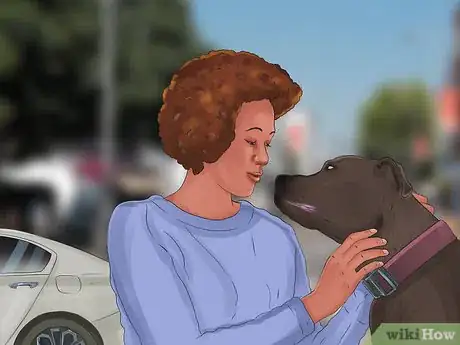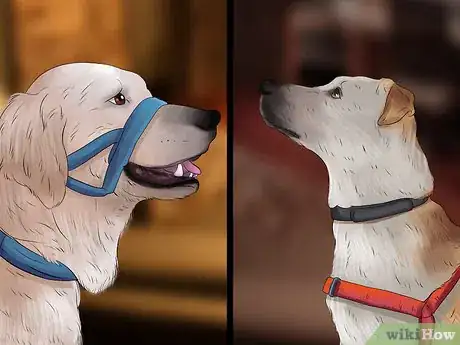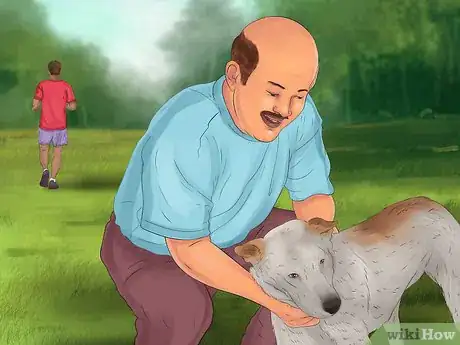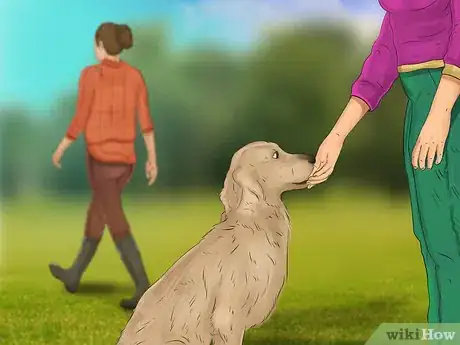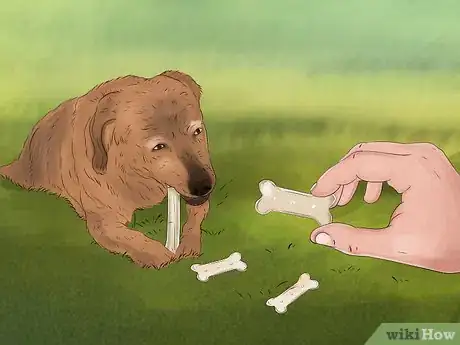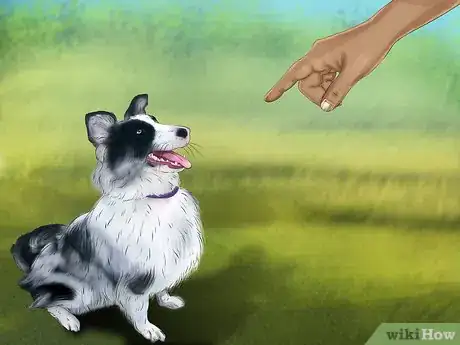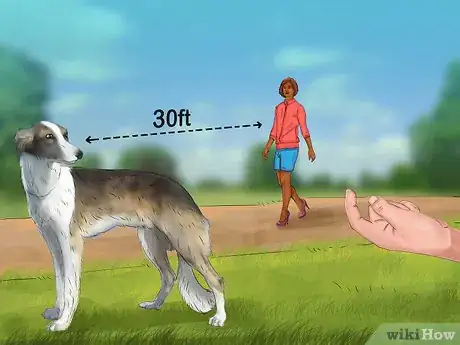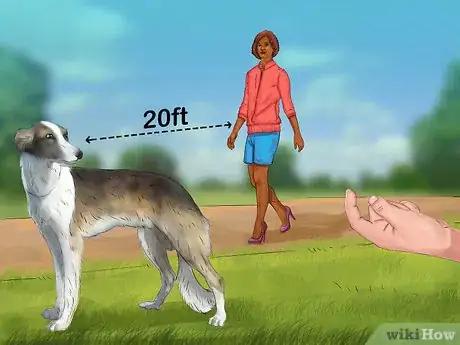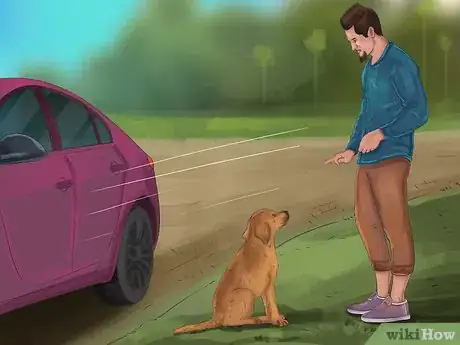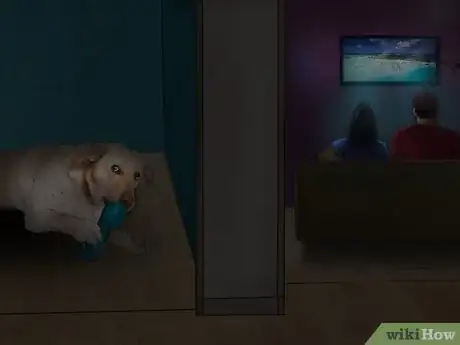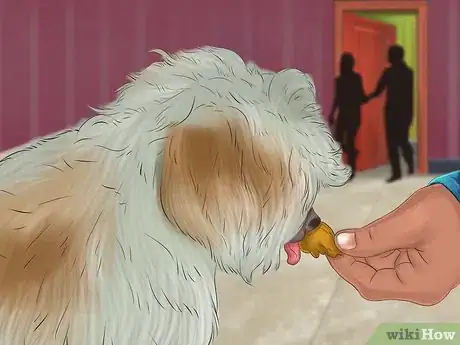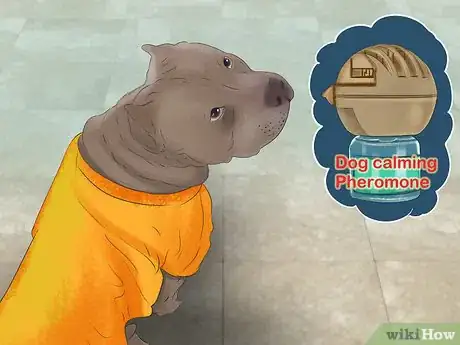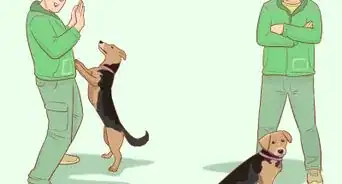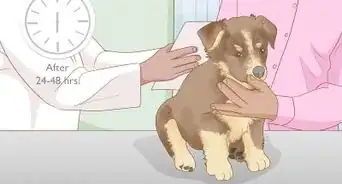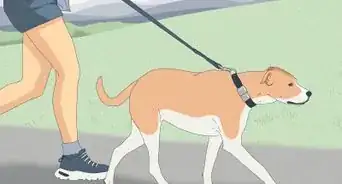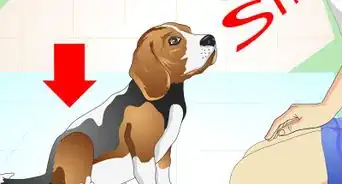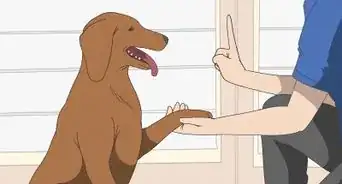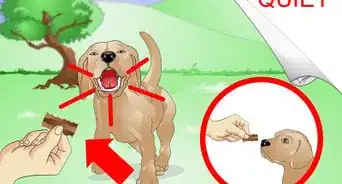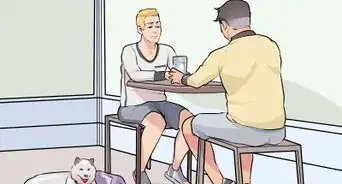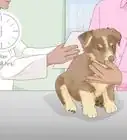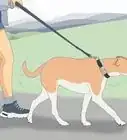This article was co-authored by Ryan Corrigan, LVT, VTS-EVN and by wikiHow staff writer, Sophia Latorre. Ryan Corrigan is a Licensed Veterinary Technician in California. She received her Bachelor of Science in Veterinary Technology from Purdue University in 2010. She is also a Member of the Academy of Equine Veterinary Nursing Technicians since 2011.
This article has been viewed 51,982 times.
If your dog lunges at passersby and cars that roll through the neighborhood, you may be looking for ways to change its behavior. There are several short-term fixes, such as avoiding the things your dog likes to lunge at, blocking your dog's view of the things it typically lunges at, and redirecting your dog's attention away from those things back to you. In the long run, it's best to train your dog to turn and sit when distractions are present. With a few simple techniques, your pooch will learn not to lunge at cars or people.
Steps
Managing Your Dog's Reactions
-
1Stay calm. Dogs that lunge at cars and people are reactive, meaning they are reacting to a fear or aggression it associates with the object or person. If you tense up or freak out, the dog is more likely to tense up or freak out as well. Stay calm and speak to your dog in a regular voice, don't shriek or yell. You can even act happy or excited, which shows your dog there is nothing to fear.[1]
-
2Keep your dog on a sturdy leash. If your dog has the tendency to lunge at people or cars, you shouldn't use a retractable leash or a long line that allows your pooch to stray far from you. Choose a leash made from a sturdy material like leather or nylon, and make sure the leash is no more than 4–6 feet (1.2–1.8 m) long. You may want to consider either a head halter or a front-clip harness to easily redirect your dog's attention from things they wish to lunge at.[2]Advertisement
-
3Don't discipline your dog when they lunge. Disciplining your dog for being reactive reinforces their behavior because it teaches the dog to associate the object (car, bicyclist, etc.) with negative consequences (your yelling or actions). The dog then thinks the car or bicyclist causes bad things to happen, so the chances of the dog lunging again the next time are incredibly high.[3]
- Simply ignore naughty behavior and don't reward your pet with treats.
- You could also say “no” in a stern voice, but avoid physically punishing your dog.
-
4Avoid the things your dog lunges at. When you see a jogger approaching or a car heading your way while you are out walking your pet, avoid these temptations for your dog to lunge. Simply cross the street or turn a corner so you don't come in contact with them. Until your dog has been trained to react calmly to these things, avoiding them is often the easiest solution.[4]
- You may choose to walk your dog at night or another time when there isn't as much commotion and traffic.[5]
-
5Block your dog's view. One way to keep your dog from lunging is to avoid letting it see the person or thing it usually lunges at. When possible, block the pooch's view so that it cannot see the car or jogger. The dog will likely still be able to smell and sense the person or object, so it is learning to act calmly around it even when it isn't in the dog's direct line of sight.[6]
- It may be enough to simply put a fence around your property or duck behind a hedge when you see the mailman coming.
-
6Redirect your dog's attention. Divert your dog's attention from an oncoming pedestrian or car to yourself. When your dog notices something or someone they would normally lunge at, call the dog's name. Then, offer the dog's favorite toy or a small treat when it looks at you. This teaches your dog to associate the person or car with attention or treats from you, which can prevent the dog from lunging.[7]
- The goal is to make yourself, the treat, or the toy more interesting than whatever has gotten your dog's attention.
-
7Distract your dog with treats. Lead your dog away from trouble by creating a treat path for them to follow. Prepare several fingernail-sized pieces of a treat that your dog enjoys -- the smellier the better! When you see something about to pass by that your dog would normally lunge at, drop a treat right in front of your dog. Once the dog finds it, drop another one, then another one once that one is eaten.[8]
- Continue doing this, dropping the treats along the path you wish for them to follow.
- Bringing along a high-value toy could also work to distract your dog.
Training Your Dog to Turn and Sit
-
1Teach your dog to turn to you at the sound of its name. To get your dog to turn and sit when distractions are present, start by calling your dog's name and rewarding it with a small treat when it turn to you. Do this throughout the day, in several different locations. To begin, you should practice this technique when no distractions, like joggers or cars, are present.[9]
- If you're having a hard time getting the dog to turn to you when you say its name, use a squeaker toy or clicker in conjunction with the dog's name.
- Keep working on this until your dog immediately turns to you whenever you say its name.
-
2Train your dog to sit on command. Once your dog consistently turns to you when their name is called, move on to getting them to sit. To get your dog to sit, hold a treat just above nose level, say “sit,” and move the treat toward the back of its head. Reward the dog with the treat when it sits. Again, this is something you should practice at multiple times in various locations.[10]
-
3Practice both commands together. Call your dog's name, then say sit, and reward it for complying when they turn to you then sit. Your dog will begin to associate their name with the command to sit, and before long, your dog should turn and sit when you call their name.[11]
-
4Invite a friend over to test your dog's obedience with these commands. Ask a friend to come over and drive or walk past you and your dog while practicing this technique. Have them start a fair distance away from you, like 30 feet (9.1 m). Cue your dog to turn and sit when it notices your friend or their car. If your dog has trouble obeying in their presence, ask them to move farther away until your dog learns to ignore them and focus on your commands.[12]
- Keep your dog on a leash while practicing this technique to ensure everyone remains safe.
- Provide small treats the entire time the dog remains sitting.
-
5Have your friend move closer gradually. Once your dog is obeying the commands to turn and sit when your friend is a fair distance away, ask them to move closer. Practice the technique at 20 feet (6.1 m), then 10 feet (3.0 m) once the father distance is mastered. Continue until your pooch obeys even when your friend is right next to you both.[13]
-
6Put this technique to use when out and about. When you see something or someone your dog would normally lunge at, cue the dog to turn and sit. Provide treats each time your pet obeys. Eventually, people and cars should be able to pass right by the 2 of you and your dog will learn to turn and sit when they see the person or car coming.[14]
-
7Get a professional dog trainer, if necessary. If you are having trouble teaching this technique to your pooch, if you simply want to make sure you are doing it right, or if you'd like extra support, contact a professional dog trainer. Ask your veterinarian for a referral, or do an Internet search to find reputable trainers in your area.
- A professional dog trainer can help you with this technique as well as provide additional tips and tricks to keep your dog from lunging at cars and people.
Dealing with House Guests
-
1Put your dog in a separate room. If you know people are coming over and your dog typically reacts badly to guests, put your dog in a separate room before they arrive. This will reduce the dog's anxiety and prevent it from lunging at your family members or friends. Provide treats and entertainment for your pet, such as a stuffed Kong ball along with its favorite toys, while your guests are present.[15]
-
2Teach your dog to associate treats with guests. If you aren't keen to lock up your dog when guests are over, teach your dog to associate treats with guests. Provide your dog with a tiny treat when the doorbell is rung, and another one when the door is opened. Keep giving treats while the guests are in your dog's sight.[16]
- You can lead the dog to another room, or have the guests move to a different space, but stop giving the treats when the guests are no longer visible to your pet.
- You can also use treats and toys to train your dog to sit when people enter your home and stay in the same place until released by your command.
-
3Utilize other calming tools. Your dog may benefit from other calming tools, such as dog appeasing pheromones. You can get a diffuser to distribute these pheromones throughout your home to help calm your pet. Alternatively, you may want to put your dog in a tight t-shirt, ThunderShirt, or Anxiety Wrap. These help your dog feel safe and secure when things that make it anxious are present.[17]
References
- ↑ https://www.dvm360.com/view/better-walk-training-dogs-not-lunge-growl-and-pull-leash
- ↑ http://www.vetstreet.com/our-pet-experts/how-can-i-get-my-dog-to-stop-lunging-at-cyclists-and-runners
- ↑ https://www.vetbabble.com/dogs/training-and-behavior/dog-lunges-during-walks/
- ↑ http://www.quickanddirtytips.com/pets/dog-behavior/4-tips-to-handle-your-lunging-barking-dog
- ↑ https://www.vetbabble.com/dogs/training-and-behavior/dog-lunges-during-walks/
- ↑ http://www.quickanddirtytips.com/pets/dog-behavior/4-tips-to-handle-your-lunging-barking-dog
- ↑ http://pets.webmd.com/dogs/guide/car-chasing-break-dogs-habit#1
- ↑ http://www.quickanddirtytips.com/pets/dog-behavior/4-tips-to-handle-your-lunging-barking-dog
- ↑ http://www.vetstreet.com/our-pet-experts/how-can-i-get-my-dog-to-stop-lunging-at-cyclists-and-runners
- ↑ http://www.vetstreet.com/our-pet-experts/how-can-i-get-my-dog-to-stop-lunging-at-cyclists-and-runners
- ↑ http://www.vetstreet.com/our-pet-experts/how-can-i-get-my-dog-to-stop-lunging-at-cyclists-and-runners
- ↑ http://www.vetstreet.com/our-pet-experts/how-can-i-get-my-dog-to-stop-lunging-at-cyclists-and-runners
- ↑ http://www.vetstreet.com/our-pet-experts/how-can-i-get-my-dog-to-stop-lunging-at-cyclists-and-runners
- ↑ http://www.vetstreet.com/our-pet-experts/how-can-i-get-my-dog-to-stop-lunging-at-cyclists-and-runners
- ↑ http://yourdogsfriend.org/help/people/
- ↑ http://yourdogsfriend.org/help/people/
- ↑ http://yourdogsfriend.org/help/people/
About This Article
To keep a dog from lunging at cars and people, start by keeping it on a leash made from a sturdy material, like leather or nylon, and make sure there's no more than 4-6 feet of slack. Then, try to avoid the things your dog lunges at or find a way to block your dog's view so it can't see the car or person. Next, teach your dog simple verbal commands, like "sit" and to turn to you at the sound of its name, so you can control its behavior. It's also important to stay calm when your dog lunges and never yell at or hit your dog, which can actually make the lunging worse. For more training tips that might help you keep your dog from lunging, read on!
